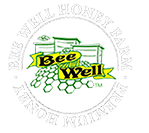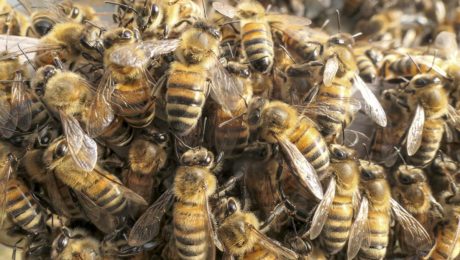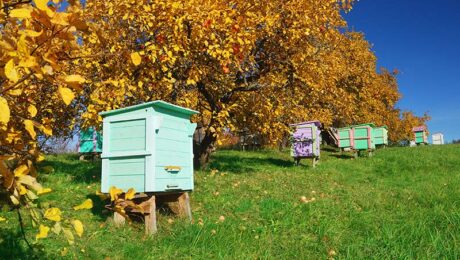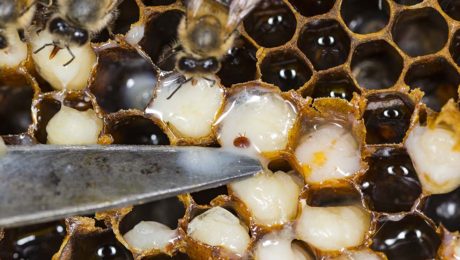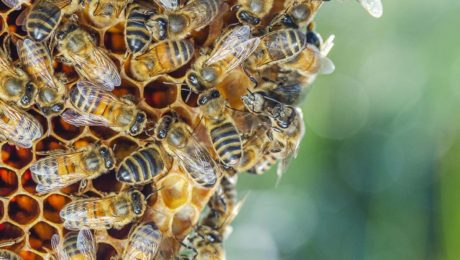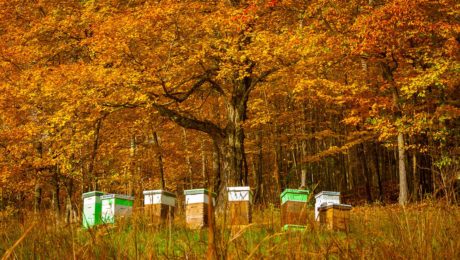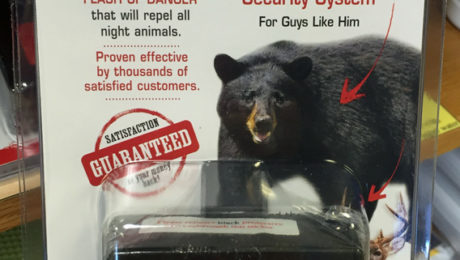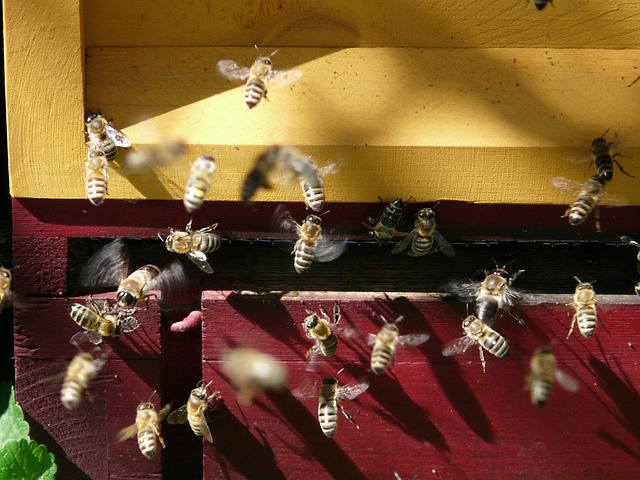What’s happening in the hive?
We’ve begun a new year, and the curious beekeepers can’t help but wonder what those winter honeybees are doing. We packed
up the colonies with food during the fall and hoped for the best. Now we still have a few months of potentially cold weather before we can hope for extended Spring temperatures. Genetics always plays an important part in honeybee behavior and some bees will be active at colder temperatures than others.
Hopefully, the bees are alive and existing in a cluster. Winter honeybees do not hibernate but they will cluster together for warmth during cold weather and become inactive. Honey is the fuel that the bees use for energy to vibrate their wing muscles and create heat. No honey – no heat – dead bees. Too much warm weather during winter can be as bad as too cold. The bees may eat all of their winter stores before the spring flowers appear and starve as a result.
New Life Begins in the beehive
Some queens may lay a small amount of brood all winter but most take a break during late fall. If you do a minimal inspection of your hive during late winter you may find a small patch of brood. This is a good sign. As January progresses and the red maples bloom, our winter honeybees are already thinking about Spring.
The Beekeeper’s Fall is a special time for human and bee alike. The hot muggy days of the southern summer are almost at an end. Most bee colonies have been at their largest population and are starting reduce in number. As the “cluster” size diminishes the beekeeper will want to make sure that the colony is not left with too much space to patrol . Too much inside space with too few patrol bees can result in an infestation of pests such as Small Hive Beetles or Wax Moths. The Beekeeper in Fall will also need to evaluate the amount of honey that is stored for winter. Bees do not fly when the weather is cold and winter (even in our area) rarely offers much in the way of nectar. Failure to provide the bee colony with proper winter food is a failure on the part of the fall Beekeeper.
Enjoy the cooler weather. Inspect your colonies before it gets too cold. Get ready for a nice winter rest while your bees are resting and dreaming of Spring.
Our honeybees are off across the hills enjoying the last bit of nectar before winter. The shortening daylight hours and the cool night temps are signaling the end of the harvest season for beekeepers everywhere. Honeybees will not be able to collect nectar during the cold winter months even though they may fly out on warm days. They must have sufficient stored honey and pollen to meet their needs until the first blossoms of late winter/early spring. The fall flow in our area will sometimes result in a small amount of honey for the beekeeper but it is usually reserved for adding to the bees winter storage.
The Fall Flow (if you are lucky enough to have one in your area) will consist of many flowers – some of which are not very noticeable. One of the most showy is the Goldenrod. There are different types of  Goldenrod and the amount of nectar they secrete will vary between types and weather conditions. Remember, just because you see a beautiful bloom does not guarantee a good fall nectar flow. Observing Goldenrod in bloom in a field or along the roadside, you will notice not only honeybees but also many different types of wasps, bumblebees and other pollinators. All of these insects are enjoying the last nectar and pollen of the season. The honeybees will hopefully overwinter as a group in their hive and the reproductive “queen” wasps and bumblebees will hibernate and start a new family group next Spring.
Goldenrod and the amount of nectar they secrete will vary between types and weather conditions. Remember, just because you see a beautiful bloom does not guarantee a good fall nectar flow. Observing Goldenrod in bloom in a field or along the roadside, you will notice not only honeybees but also many different types of wasps, bumblebees and other pollinators. All of these insects are enjoying the last nectar and pollen of the season. The honeybees will hopefully overwinter as a group in their hive and the reproductive “queen” wasps and bumblebees will hibernate and start a new family group next Spring.
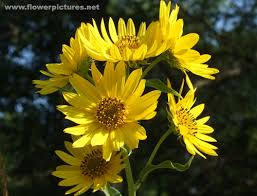
Sawtooth Sunflower blooms from mid-August to late October in moist areas and partial shade. This plant is good for bees and serves as browse for deer also.
Aromatic Aster (above right) is a small plant you will find from mid-September to November in sunny fields and woodland edges. Several different types of Aster contribute to our bees needs and provide nectar until a deep freeze.
One of the most important tasks for a beekeeper is to make sure their managed bee colony has sufficient winter food before cold weather begins. Once a deep freeze has killed all the available blooms, the bees will only find a few sheltered blossoms until the first dandelions of Spring.
Varroa mites are a parasitic pest of honeybees and create a “world of woes” for beekeepers worldwide. They  developed in Indonesia – where they only reproduced in drone brood and did little damage to the bee colony as a whole. In other parts of the world, Varroa has had a devastating effect on Apis Mellifera (our European Honeybee). The reddish mites are small but visible to the naked eye. They suck the blood (hemolymph) from adult bees and feed off of brood. In addition to weakening the bees, the mite also serves are a vector for viruses. There is no treatment for a virus. Our best plan of management is to keep the “mite load” low so we will have the largest number of healthy bees possible.
developed in Indonesia – where they only reproduced in drone brood and did little damage to the bee colony as a whole. In other parts of the world, Varroa has had a devastating effect on Apis Mellifera (our European Honeybee). The reddish mites are small but visible to the naked eye. They suck the blood (hemolymph) from adult bees and feed off of brood. In addition to weakening the bees, the mite also serves are a vector for viruses. There is no treatment for a virus. Our best plan of management is to keep the “mite load” low so we will have the largest number of healthy bees possible.
August is the time of year when varroa mite numbers start to explode in our area. Also, the queen bees may slow or stop laying eggs and the result is a lower number of bees and more mites. Hot daily temperatures in August causes many beekeepers to be less than vigilant in monitoring their hive and the total collapse of the colony may be the result. There are many resources online regarding how to take a “mite count” and how many are too many. Sometimes these sources disagree but the general consensus is that if you do a “sticky board count” you don’t want more than 50 mites dropped in a 24 hour period in August.
Once you have an idea of how infested your colony may be, you need to decide on a treatment option. Bee Well Honey has several products available for mite control. Ranging from a synthetic chemical (such as Apistan) to the “softer” more natural options such as “thymol” or “mite away”. Beekeepers have wonderful arguments over the best treatment method but there seems to be no silver bullet for varroa. Each product has directions on the package. Be sure to read and follow directions in regards to placement and removal of strips and temperature restrictions.
Managing varroa levels now will help insure that you have healthier bees in September that will be able to raise healthy over-winter bees.
Don’t delay – send mites away !
Estimated reading time: 2 minutes
A gaggle of geese, a herd of cows, a pack of wolves, a cluster of bees…. it’s all semantics.
Honeybee Cluster
What is the cluster size? This is a common question you may hear among beekeepers when discussing the size of a honey bee colony. The honeybee cluster is the main brood area of the hive. Here the queen will lay eggs and the nurse bees will feed the young. Honey and pollen will be stored nearby for ready access. The cluster area is the “heart of the hive”, especially in winter.
Most of the year, the honeybees will be spread out over the frames going  about their daily chores. But the arrival of cool weather forces the bees to begin the clustering behavior. Because of the rearing of young, the brood area must be kept warm. When brood is present the temperature at the center of the honeybee cluster will be near 94 degrees. The bees produce heat by moving their wing muscles. As you move toward the outside of the cluster the temperature will drop. When the weather gets colder, the bees cluster tighter together.
about their daily chores. But the arrival of cool weather forces the bees to begin the clustering behavior. Because of the rearing of young, the brood area must be kept warm. When brood is present the temperature at the center of the honeybee cluster will be near 94 degrees. The bees produce heat by moving their wing muscles. As you move toward the outside of the cluster the temperature will drop. When the weather gets colder, the bees cluster tighter together.
Most beekeepers want a large cluster of bees going into late Fall. Throughout the winter, some of the older bees will die and the hive population will decrease. We want a colony to have a large enough population to sustain some loss before new bees begin to appear in late winter.
Genetics also plays a part in cluster size. Some strains of bees (such as Russians or Carniolans) will carry smaller clusters into winter and then expand the brood nest rapidly upon the arrival of early Spring.
When bitter cold weather arrives, the bees will not leave the cluster to bring honey close by. If the cold weather continues until the honey supply near the cluster is exhausted – the bees will die. This is especially a danger to small clusters. So, a honeybee colony can perish even when they have a full super of honey on top or several frames away. The honey stores have to be in the right place at the right time.
We wish the very best for all of our beekeeping friends and their bees during this winter weather!
This is a great time of year to prepare new equipment for Spring. We have everything you need: order here
What is the best way to get started as a beekeeper? The first step in your journey may be to choose a source of bees! When buying bees, you will be faced with the decision of purchasing package bees vs nucs. Both choices have advantages and disadvantages.
Package Bees
Thousands of packages of honeybees are sold each year. The most popular size is a 3# (weight) package of bees with a young mated queen. They are transported inside a small wire/wooden box with a can of sugar syrup to feed them on their journey.
Package Bees are the most economical and readily available source of bees. Generally available early in the Spring season, package bees are often preferred for beekeepers who want to get started early in the season.
Nucs
Nucs (also know as nucleus colonies) are small starter bee colonies. A nuc usually consists of 5 frames of bees (including drawn comb, honey and brood) and a mated queen. Not all nucs are created equal and when purchasing you should be clear on the size of the colony (# of frames) you are purchasing.
Which is better – packages vs nucs ?
Which is better for the new beekeeper? Packages vs nucs? Unfortunately, there is no clear answer to this question and the best answer will depend on the genetics of the bees involved, the climate/geographic location and the management style of the beekeeper.
Packages vs Nuc (the nitty-gritty)
Package Bees are more economical, less prone to spread pests or diseases (because no honeycomb is involved), and are more readily available. They are slower to build up a working population and have to go through the queen acceptance procedure.
Nucs – Nuc colonies are more expensive than packages of bees. They include a drawn honeycomb, some brood, and bees to cover the frames. Their mated queen will already be laying and accepted. This gives them a jump start initially over package bees. However, the presence of a drawn comb also brings with it the opportunity for pests and disease.
Both package bees and nucs are a great way to get started in beekeeping. Bee Well Honey Farm has been providing bees to area beekeepers for more than 20 years. Always purchase your bees from a reputable dealer and this will help ensure that you get off to the best start possible.
We Want You for Bee Well Bootcamp
This in-depth beekeeping class covers all the crucial details of starting with bees. This course begins with a Lecture and concludes with Field Instruction.
Cost
$75
Class Schedule
March 7, 2020
10:00 am – 12:00 pm Lecture
1:00 pm – 4:00 pm Field Instruction
Lecture Includes
- How to install, feed, and medicate your bees
- Behaviors of the bees
- Detection of mites, beetles, and diseases
Field Instruction Includes
- Examine real beehives
- Hands-on interaction with the bees
Class Instructor – Kerry Owen
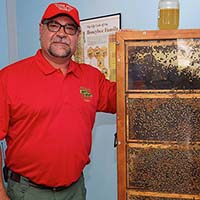
Becoming a Beekeeper is an exciting journey that many people wait years to experience. Unless you are lucky enough to have a beekeeper in your family, you might find yourself exploring the possibilities during mid life or later. This is okay. Beekeeping can be a meaningful adventure for young and old alike. Even though the craft does involve hard work and some heavy lifting, you can learn management techniques to help lighten the load.
Becoming a Beekeeper involves not only an education in honeybee biology and maintenance but also an understanding of natural local botany and climate conditions. Good beekeepers need to know when the food providing plants will bloom in their area. Weather conditions can affect honeybee colonies significantly and beekeepers must be prepared to step in when conditions warrant.
Those most likely to succeed will prepare well in advance of actually receiving the honeybees. Selecting a proper location, assembling equipment and learning the basics of honeybee management will help you to become a beekeeper worthy of the name. Remember you want to become a successful beekeeper not a “bee haver” .
Honeybee colony inspections are a very important part of being a good beekeeper. The beekeeper has to decide when to intervene and when to leave the bees to their own plans.
Honeybee colonies do not require a lot of management on a regular basis but there will be times of the year when you need to do perform important maintenance. Right now is one of those times.
The bulk of the honey flow is over in our area and most beekeepers have harvested the excess. Now is the time to make sure the bees have lots of stores left and to plan for any mite treatments. Healthy bees in September will produce healthy bees in October for the important over wintering population.
Check out our Beekeeping Tips for September for more information about what we recommend you do in this month.
Beekeeping Class
Would you like to know more about honeybees? Do you wonder what all the fuss is about? Could you picture yourself in a beekeeping suit but are afraid to try?
If you answered yes to any of these questions, our beekeeping class may be for you.
Our popular one day Beekeeping Boot Camp is a good introduction to the world of the honeybee.
This beekeeping class will give you a great start on your journey to become a new beekeeper.
Commercial Beekeeper, Kerry Owen, owns Bee Well Honey Farm and operates over 2000 hives.
Our next class is Saturday March 11, 2017- cost is $75. Register now.
Protecting Your Bees with Nite Guard
Beekeepers are charged with protecting their colonies from pests, diseases, environmental conditions and predators. It is common to think of your bees as pets – even though they are considered “livestock” by USDA. Beekeepers in many areas of the country deal with predators such as : skunks, opossums, bears and humans. All of these “animals” may cause problems for your bees in the upstate of South Carolina.
Nite-Guard is a solar powered predator deterrent. Charged by the sun during the day, the solar light activates at dusk and flashes all night. Nite Guard is weather-proof and earth friendly. Safe for people, pets and livestock – it looks like a security camera and may even deter intruders. Many wild animals are distrustful of the flashing red light that signals danger. While no items works in every situation with every type of predator, these lights have proven very beneficial for many users around the county.
Placement of your nite-guard lights will vary depending on the type of animal you are targeting. The company has a great website that gives the consumer tips and ideas to ensure the best use of the product. Nite Guard
Bee Well Honey is proud to offer Nite Guard to our customers for use in your beeyard, garden or home.
This DVD is a great way to spend a hot summer afternoon. Pour yourself a glass of iced sweet tea and kick back in the air-conditioning. Vanishing of the Bees is a 2009 documentary film by Hive Mentality Films & Hipfuel films, directed by George Langworthy and Maryam Henein and released in the United Kingdom. Available in our store for $14.99 plus tax.
Package Bees the first summer
Across the Carolinas, many beekeepers buy package bees each year to fill up boxes from lost winter colonies or to expand their bee yard. Package Bees are also the starting point for many new beekeepers. Though some people recommend purchasing a nuc (nucleus hive) to give your colony a headstart, many beekeepers prefer package bees and actually say that packages can out perform nucs during the season.
If you are installing your package on new foundation, your bees have a lot of work to do before they will be self sustainable. As the beekeeper, it is your responsibility to tend to the maintenance issues that will keep your packages on a good growth trend to full functioning colony.
Are you keeping the feeders full ?
Feed your bees well. If you have a lot of blooming nectar producing plants in the area, your package bees may actually slow consumption of sugar syrup or quit all together. Sugar syrup left in the feeder too long can grow cloudy or even mold. When the natural nectar dries up as the summer grows hot and dry, colonies that had been ignoring your feeder may suddenly consume the syrup at an alarming rate. Bee Well Honey recommends feeding your colony until the bees have “drawn out” on all 10 frames in the hive body and at least a shallow supper. We want the shallow supper to be full of honey before the end of fall. Don’t neglect proper feeding during this first summer. Always, remove the feeder when adding honey collection suppers for yourself.
Check your Queen periodically
Bee Well Honey always reminds you to check your queen status a few weeks after installing a package of bees. We want to see the queen present and a good brood pattern. What is a good brood pattern ? A nice area of capped brood with few empty cells in the area, brood of similar ages grouped together, not an overabundance of drone brood and drone brood should be on the perimeter of the nest area not in the middle.
If you have trouble finding your queen, don’t panic. Keeping a marked queen in your hive does make it easier to locate her on a frame with thousands of bees. You don’t have to look for the queen everytime you inspect your colony. In fact, you may be disturbing the bees unnecessarily and causing them stress. Instead look for signs of the queen, if you see a good brood pattern with fresh larva and eggs chances are your queen is just fine. Check for her presence at least once a month throughout the summer. If your colony swarms (yes packages CAN swarm their first year) you want to make sure the colony is successful in requeening itself.
Mites & Pests
By mid summer the varroa mite population will be climbing. Research and decide on a varroa management plan for  your hives. There are several different methods for evaluation and treatment. Doing nothing for mite control is not an option for most of us. Mites can weaken your colony even if they do not cause the collapse of your hive completely. You will need to implement your plan in mid Summer to allow for healthy winter bees to emerge in the Fall.
your hives. There are several different methods for evaluation and treatment. Doing nothing for mite control is not an option for most of us. Mites can weaken your colony even if they do not cause the collapse of your hive completely. You will need to implement your plan in mid Summer to allow for healthy winter bees to emerge in the Fall.
We want our Spring Bee Packages to have a good laying queen, a plentiful population of healthy bees and a full food super come October. Do you best and remember that beekeeping isn’t always easy and sometimes the beekeeper who does his/her best will still experience hive failures. Don’t give up, beekeeping is a learning process that takes time and patience.
Happy Bee Keeping – Bee Well Honey
 Package Bees Are Coming
Package Bees Are Coming
Kerry Owen has the red freightliner loaded down with package bees for our sold out bee day tomorrow ! Hundreds of excited beekeepers will be at the Pickens store bright and early Saturday morning to pick up bees that they have preordered. Each box of bees contains a mated queen, approximately 3# (10,000) bees and a can of sugar syrup for the journey. (You take snacks when you travel right ?) Bees need constant energy and this can of sugar will provide that until the new owners get them home and in a hive.
Kerry is very serious about providing good package bees for our customers. He does not have them shipped but actually goes and picks up the bees himself. These Italian Hygenic bees will fill up hives all across the upstate. Some beekeepers will experiment with new lines by replacing the Italian queen with one of the Carniolan Queens we have in stock. We stock all the bees supplies you might need.
Bee Day is always an exciting time and we are opening one hour early tomorrow to allow excited beekeepers to get those bees soon. We hope that everyone has their equipment ready and some sugar water already mixed as feeding new packages is very important.
We have several more bees days planned for the next few weeks and still have a few available for sale. Visit our Bees for sale page or call (864) 898-5122 to place your order. Spring is a great time to get started in bees and we will be glad to help you on your beekeeping journey.
Now, if you see a lot of excitement at Bee Well Honey early in the morning…. you will know why !
Honeybees and Spring
The Christmas Holidays have passed and now we begin to look towards working with our honeybees and Spring. Tired of long, damp winter days we look forward to opening the hives and evaluating the condition of our bee colonies. New beekeepers are reading and learning all they can as they prepare to establish hives for the first season. It is a great time to look for classes as most local bee associations will offer them in Jan-Feb. Bee Well Honey offers a one day Boot Camp in early March.
Red Maples are one of the first major nectar and pollen sources for the bees. You will notice the reddish blush in the tops of trees. Red Maple flowers are very small but their resources help the small overwintered colonies start their buildup for the major flowering season. Most beekeepers do not see any surplus honey from the Red Maple bloom. Cool chilly weather will prevent the bees from harvesting on many late winter days.
The pollen brought in from the Red Maples is not red but is actually a light greenish color.
Remember, bees do eat pollen but its major use is to feed their baby bees. It is a protein source. They don’t really need pollen to make honey but they do need it to make bees !
Knowing the natural bloom time of local plants is of great benefit to the beekeeper.
One of the many debated topics among beekeepers is the issue of starting new hives with package bees or nucs. A package of bees is usually a 3# screen and wire cage containing about 10,000 bees and a mated queen (in a cage) with a can of syrup for the journey. A nuc (pronounced nuke) is short for nucleus colony. A nuc should contain 4 or 5 frames of complete honeycomb including bees, brood, honey, pollen and a mated and accepted queen. Both methods have advantage and disadvantages.
nucs. A package of bees is usually a 3# screen and wire cage containing about 10,000 bees and a mated queen (in a cage) with a can of syrup for the journey. A nuc (pronounced nuke) is short for nucleus colony. A nuc should contain 4 or 5 frames of complete honeycomb including bees, brood, honey, pollen and a mated and accepted queen. Both methods have advantage and disadvantages.
Package bees is probably the most common way to grow your apiary. Thousands of bee packages are sold each year in the US. Quality varies greatly so it is important to find a supplier that delivers healthy bees. Then the job of taking care of them is up to you the beekeeper.
Disadvantages of Packages:
the bees in the box are not usually related and have not yet accepted the queen included
the bees do not have any brood or stores in honeycomb
Advantages of Packages:
you will have no sealed brood for about 10 days (this can be a varroa mite break)
available earlier in the season
cost less than nucs
easier to deal with in the beginning, smaller cluster of bees, less propolis and sticky frames, all comb built will be new
Nucs are usually 4 or 5 frames of bees, complete honeycomb, stores, brood and an accepted queen. They are generally available a little later in the season and have a head start on packages purchased at the same time of year.
Disadvantages of Nucs:
Not all nucs are created equal and involve more variables than packages. When comparing costs you should have a complete understanding of how many frames you are getting and how full of bees those frames will be. Are the frames and comb old or new ? Is the comb completely drawn out or partial or just foundation ? Plastic or wax ?
Nucs can be hard to find when you want to purchase and are not always available early due to winter/spring weather. If the Spring is especially cold and nucs are slow to develop you may end up with nothing if you miss the package delivery dates.
Nucs with drawn comb and brood can more easily carry along pests such as (hive beetles, wax moths etc) and diseases.
Nucs are more expensive
Advantages of Nucs:
A good nuc colony has a head start over a package as it has brood, stores and drawn comb.
A queen that has been accepted by the bees and has already been laying.
Both methods are great ways to get involved in beekeeping for newbies or those wanting to expand their apiaries. We are taking orders for package bee now and the earliest dates will sell out. Place your order now !
https://beewellhoneyfarm.com/beekeeping-supplies/honeybees-sale/
BEES FOR SALE
The term “bees for sale” brings forth great excitement in the minds of beekeepers everywhere. Each year Bee Well Honey in Pickens SC offers packages of honeybees for sale to new and experienced beekeepers in the region. We have been doing this for over 10 years and we believe that we have a good system of providing new colonies to meet your needs. Honeybees are facing many difficulties and there is no perfect bee or perfect beekeeper. Getting your colony off to a good start in early Spring is an important part of having a successful beekeeping program. Interested in Bees but don’t know how to become a beekeeper ? Bee Well can help you there also with our experienced staff and one day Beekeeping BootCamp. Order your packages now to secure the best early dates and be ready to start off 2015 with a “BUZZ” !
Click here to order
Even though we are still in the grips of a hot southern summer – next Spring will arrive before we know it. This is a great time to pre-order honeybees for delivery next March-April. Buying honeybees is an important step for new beekeepers or those wanting to expand their bee yard.
Many people do not realize that the earliest honeybee delivery dates always sell out. Those beekeepers who order early are best assured of prime pickup dates.
Bee Well is taking orders NOW for Spring Delivery of Honeybee Packages
Pickup Dates will be made available when the orders are finalized in early January.
3# Italian Pkg with mated Queen $95 cash $97 credit card
Call to reserve your packages today !
864-898-5122
Beehive Bearding is often a very scary site for the new beekeeper. This most often happens with strong colonies in the hot humid summertime. Temperatures inside the colony must be kept near 92 degrees F to support proper brood rearing. If the temp gets too high – brood will die. Bees control internal temperatures by fanning air throughout the hive, as well as placing water drops on the surface of the comb to provide evaporative cooling. To aid in the process, a large number of bees will often be seen hanging on the outside of the hive (we call this bearding) especially in the late afternoon and evenings of the summer. While this activity is not an indicator for swarming, it does mean that the colony may be strong and may need additional monitoring. So, don’t be too alarmed at the site of a large beehive beard, it is just another wonderful miracle of the bee.
Nucleus Colonies (also known as nucs) are a valuable tool for the backyard beekeeper. Nucleus colonies contain 5 large brood frames instead of the 10 that is normal for a basic hive. These nuc colonies will house the queen and enough bees to maintain a small family and carry on regular hive operations. They do require more management than a regular size hive because they can outgrow their space quickly. Once the main honey flow is over and we still have plenty of summer (warm) weather, you still have time to set up a few nucleus colonies. There are many ways to make nucs (or splits). One of our favorites is to remove 3 frames of bees (capped brood) from a overcrowded colony. (Be sure to get some with capped brood, honey and pollen) Then add one frame of very fresh eggs ( 1 day old), this will allow the bees to make a new queen for the nuc. Be sure to put a lot of bees in the small colony to ward off a small hive beetle invasion. Feed the nuc until they are well established and the new queen has bees hatching – longer if needed to finished comb construction and storage of honey. Bee Well Honey has nuc woodenware ready to assemble for $ 43.95 plus tax.
The Honeybee buzz is on at Bee Well Honey. The Spring flow continues with the honeybees gathering nectar from many available blooming plants. This nectar is ripened and transformed into pure sweet honey for all of you to enjoy. The process from nectar to finished honey takes several weeks. As the honeybees finish the honey, we will be extracting (actually we have already started) and new honey becomes available. Enjoy the golden sunshine collected by our honeybees and made available for your enjoyment. Drop by our Pickens store, one of our retail partners or order online today !
